

Eureka Math® Grade K Modules 1
& 2
Published by Great Minds PBC
Student Name:
What does this painting have to do with math? Turn this book over to find out.
Succeed Eureka Math® Grade K Modules
1 & 2
VIRGINIA EDITION
Great Minds © is the creator of Eureka Math® , Wit & Wisdom® , Alexandria Plan™, and PhD Science®
Published by Great Minds PBC. greatminds.org
© 2022 Great Minds PBC. All rights reserved. No part of this work may be reproduced or used in any form or by any means—graphic, electronic, or mechanical, including photocopying or information storage and retrieval systems—without written permission from the copyright holder.
Printed in the USA
10 9 8 7 6 5 4 3 2 1
ISBN 978-1-64497-842-9
Learn ♦ Practice ♦ Succeed
Eureka Math® student materials for A Story of Units® (K–5) are available in the Learn, Practice, Succeed trio. This series supports differentiation and remediation while keeping student materials organized and accessible. Educators will find that the Learn, Practice, and Succeed series also offers coherent—and therefore, more effective—resources for Response to Intervention (RTI), extra practice, and summer learning.
Learn
Eureka Math Learn serves as a student’s in-class companion where they show their thinking, share what they know, and watch their knowledge build every day. Learn assembles the daily classwork—Application Problems, Exit Tickets, Problem Sets, templates—in an easily stored and navigated volume.
Practice
Each Eureka Math lesson begins with a series of energetic, joyous fluency activities, including those found in Eureka Math Practice. Students who are fluent in their math facts can master more material more deeply. With Practice, students build competence in newly acquired skills and reinforce previous learning in preparation for the next lesson.
Together, Learn and Practice provide all the print materials students will use for their core math instruction.
Succeed
Eureka Math Succeed enables students to work individually toward mastery. These additional problem sets align lesson by lesson with classroom instruction, making them ideal for use as homework or extra practice. Each problem set is accompanied by a Homework Helper, a set of worked examples that illustrate how to solve similar problems.
Teachers and tutors can use Succeed books from prior grade levels as curriculum-consistent tools for filling gaps in foundational knowledge. Students will thrive and progress more quickly as familiar models facilitate connections to their current grade-level content.
Students, families, and educators:
Thank you for being part of the Eureka Math® community, where we celebrate the joy, wonder, and thrill of mathematics.
Nothing beats the satisfaction of success—the more competent students become, the greater their motivation and engagement. The Eureka Math Succeed book provides the guidance and extra practice students need to shore up foundational knowledge and build mastery with new material.
What is in the Succeed book?
Eureka Math Succeed books deliver supported practice sets that parallel the lessons of A Story of Units® Each Succeed lesson begins with a set of worked examples, called Homework Helpers, that illustrate the modeling and reasoning the curriculum uses to build understanding. Next, students receive scaffolded practice through a series of problems carefully sequenced to begin from a place of confidence and add incremental complexity.
How should Succeed be used?
The collection of Succeed books can be used as differentiated instruction, practice, homework, or intervention. When coupled with Affirm® , Eureka Math’s digital assessment system, Succeed lessons enable educators to give targeted practice and to assess student progress. Succeed’s perfect alignment with the mathematical models and language used across A Story of Units ensures that students feel the connections and relevance to their daily instruction, whether they are working on foundational skills or getting extra practice on the current topic.
Where
can I learn more about
Eureka Math resources?
The Great Minds® team is committed to supporting students, families, and educators with an ever-growing library of resources, available at eureka-math.org. The website also offers inspiring stories of success in the Eureka Math community. Share your insights and accomplishments with fellow users by becoming a Eureka Math Champion.
Best wishes for a year filled with Eureka moments!

Jill Diniz Director of Mathematics Great Minds
Module 2: Two-Dimensional Shapes and Repeating Patterns
Grade K Module 1
Color the things that are exactly the same. Color them so that they look like each other.

Analyze to find two objects that are exactly the same or not exactly the same.
Lesson 1:
Name Date
Color the things that are exactly the same. Color them so that they look like each other.

Draw a line between two objects that match. Use your words. “These are the same, but this one is , and this one is .”

Lesson 2:
Name Date
Draw a line between two objects that match. Use your words. “These are the same, but this one , and this one .”

Make a picture of 2 things you use together. Tell why.

Classify to find two objects that share a visual pattern, color, and use.
Lesson 3:
Name Date
Draw something that you would use with each. Tell why.

Make a picture of 2 things you use together. Tell why.

Lesson 3:
Make two groups. Circle the things that belong to one group. Underline the things that belong to the other group. Tell someone why the items in each group belong together. (There is more than one way to make groups!)

Classify items into two pre-determined categories. Represent items in an object graph.
Lesson 4:
Name Date
Make two groups. Circle things that belong to one group. Underline the things that belong to the other group. Tell someone why the items in each group belong together. (There is more than one way to make groups!) Classify items into two pre-determined categories. Represent items in an object graph.

Use the cutouts. Glue the pictures to show where each belongs. Tell an adult how many are in each place.

Classify items into three categories, determine the count in each, and reason about how
Lesson 5:
Name Date
Use the cutouts. Glue the pictures to show where each belongs. Tell an adult how many are in each place.
Library

School

Grocery Store

Homework Cutouts

Classify items into three categories, determine the count in each, and reason about how the last number named determines the total.
Lesson 5:
Draw lines to put the treasures in the boxes.

Sort categories by count. Identify categories with 2, 3, and 4 within a given scenario.
Lesson 6:
Name Date
Draw lines to put the treasures in the boxes.

Sort categories by count. Identify categories with 2, 3, and 4 within a given scenario.
Count and color.

Sort by count in vertical columns and horizontal rows (linear configurations to 5). Match to numerals on cards.
Lesson 7:
Name
Date Count and color.

Sort by count in vertical columns and horizontal rows (linear configurations to 5). Match to numerals on cards.
Lesson 7:
Count. Circle the number that tells how many.

Answer how many questions to 5 in linear configurations (5-group), with 4 in an array configuration. Compare ways to count five fingers.
Lesson 8:
Name Date
Count. Circle the number that tells how many dots in all.

Answer how many questions to 5 in linear configurations (5-group), with 4 in an array configuration. Compare ways to count five fingers.
Lesson 8:
Count the circles, and box the correct number. Color in the same number of circles on the right as the shaded ones on the left to show hidden partners.

Within linear and array dot configurations of numbers 3, 4, and 5, find hidden partners.
Lesson 9:
Name Date
Count the circles, and box the correct number. Color the same number of circles on the right as the shaded ones on the left to show hidden partners. Within linear and array dot configurations of numbers 3, 4, and 5, find
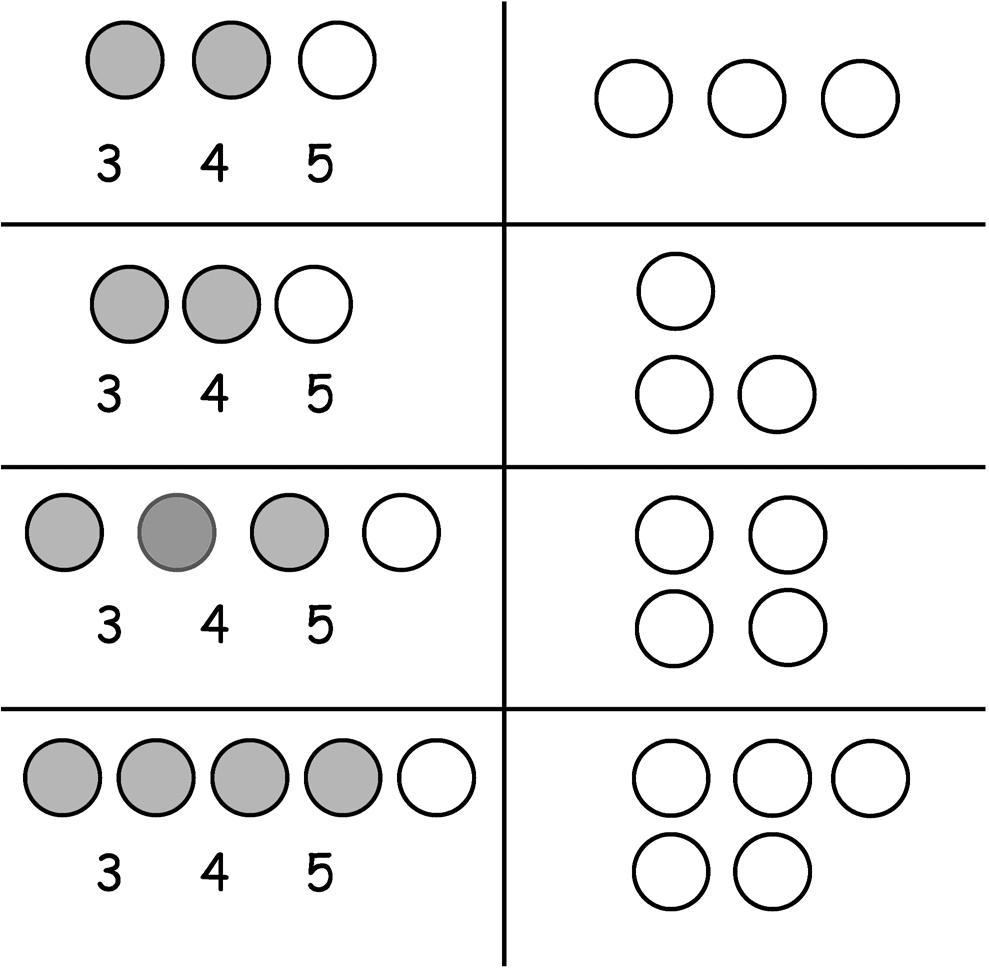
Lesson 9:
Count how many. Draw a box around that number. Then, color 1 of the circles in each group.

Within circular and scattered dot configurations of numbers 3, 4, and 5, find hidden partners.
Lesson 10:
Name Date
Count how many. Draw a box around that number. Then, color 1 of the circles in each group.

Talk to an adult at home about the hidden partners you found.
Lesson 10:
Color the shapes to show 1 + 2. Use your 2 favorite colors.

How many shapes are there?
Circle the number. 1 2 4 5

Model decompositions of 3 with materials, drawings, and expressions. Represent the decomposition as 1 + 2 and 2 + 1.
Lesson 11:
Name Date
Feed the puppies! Here are 3 bones. Draw lines to show 2 + 1.

Color the shapes to show 1 + 4. Use your 2 favorite colors.

How many shapes are there?
Model decompositions of 3 with materials, drawings, and expressions. Represent the decomposition as 1 + 2 and 2 + 1. 1 2 3 4 5
How many? Draw a line between each picture and its number.


How many are in your home?

Understand the meaning of zero. Write the numeral 0.
Name Date
How many? Draw a line between each picture and its number.

Write the number in the blank.

Understand the meaning of zero. Write the numeral 0.
Count the objects. Write how many.

Write the missing numbers.

Order and write numerals 0–3 to answer how many questions.
Lesson 13:
Name Date

Order and write numerals 0–3 to answer how many questions.

How many pet monkeys do you have?

Write the missing numbers:

Order and write numerals 0–3 to answer how many questions.
Color the stars so that 1 is yellow and 2 are red.


There are stars.

Write numerals 1–3. Represent decompositions with materials, drawings, and equations, 3 = 2 + 1 and 3 = 1 + 2.
Lesson 14:
Name Date
Color the shirts so that 1 is red and 2 are green.

Color the balls so that 2 are yellow and 1 is blue.

Count the shapes and write the numbers. Mark each shape as you count.

How many?

Order and write numerals 4 and 5 to answer how many questions in categories; sort by count and interpret an object graph.
Lesson 15:
Name Date
Count the shapes and write the numbers. Mark each shape as you count.

How many?

Write the missing numbers. Order

Write the missing numbers:
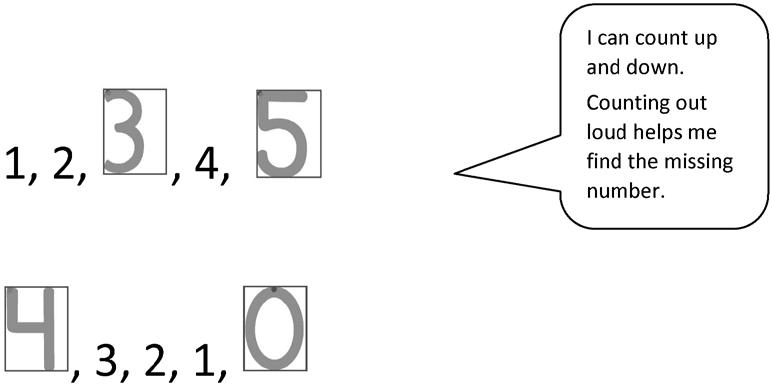
Draw 3 yellow fish and 2 green fish.


How many fish are there in all? There are fish.

Write numerals 1–5 in order. Answer and make drawings of decompositions with totals of 4 and 5 without equations.
Lesson 16:
Name Date
Write the missing numbers:

Write numerals 1–5 in order. Answer and make drawings of decompositions with totals of 4 and 5 without equations.
Lesson 16:
Draw 3 red fish and 1 green fish.
How many fish are there in all?


3 fish and 1 fish make fish.
Draw 2 happy faces and 3 sad faces.
How many faces are there in all?
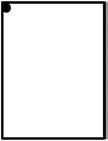

5 is the same as and
Write numerals 1–5 in order. Answer and make drawings of decompositions with totals of 4 and 5 without equations.



Connect the boxes with the same number.

Count 4–6 objects in vertical and horizontal linear configurations and array configurations. Match 6 objects to the numeral 6.
Lesson 17:
Color 4.
Color 6



Connect the boxes with the same number.

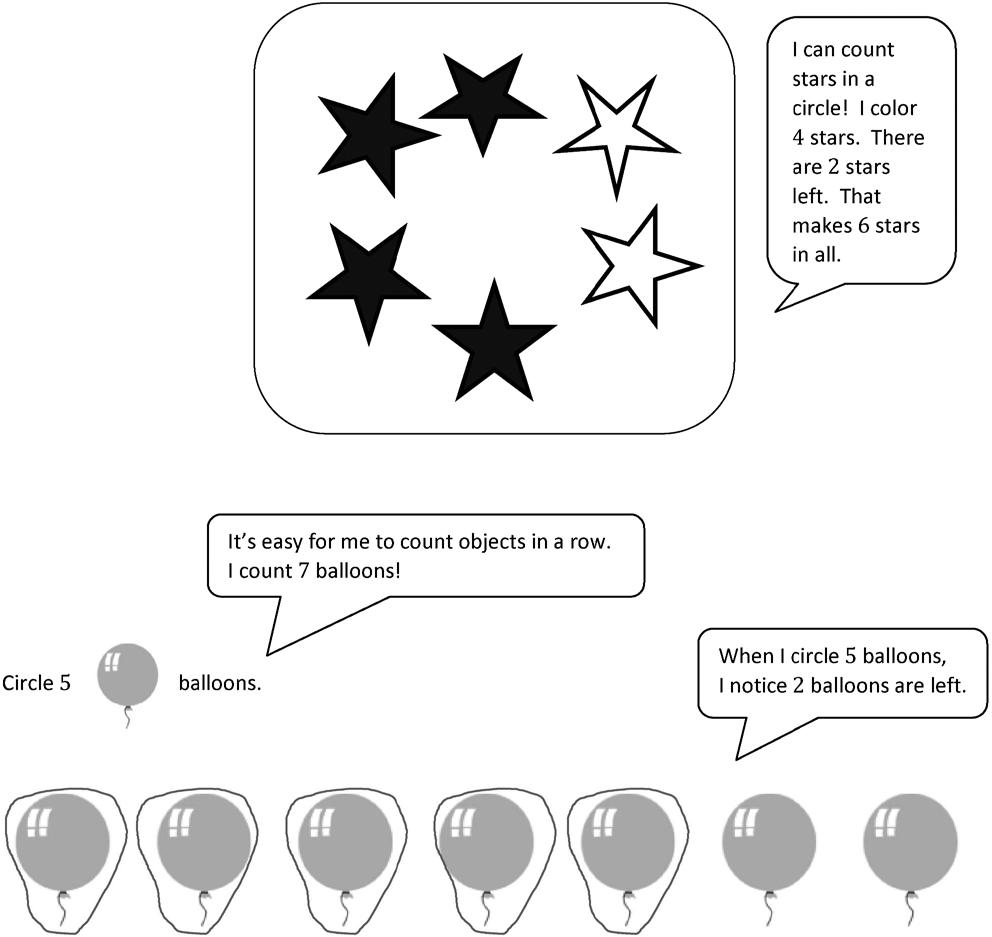
Count 4–6 pennies in circular and scattered configurations. Count 6 items out of a larger set. Write numerals 1–6 in order. Name the value of a set of pennies.
Lesson 18:
Color 4.
5. Color 6.



Circle 6 balloons.

Count 4–6 pennies in circular and scattered configurations. Count 6 items out of a larger set. Write numerals 1–6 in order. Name the value of a set of pennies.
Lesson 18:
5-group
Like fingers on a hand, we can make groups of 5 (and some more).
Draw a line from the numeral to the 5-group it matches.
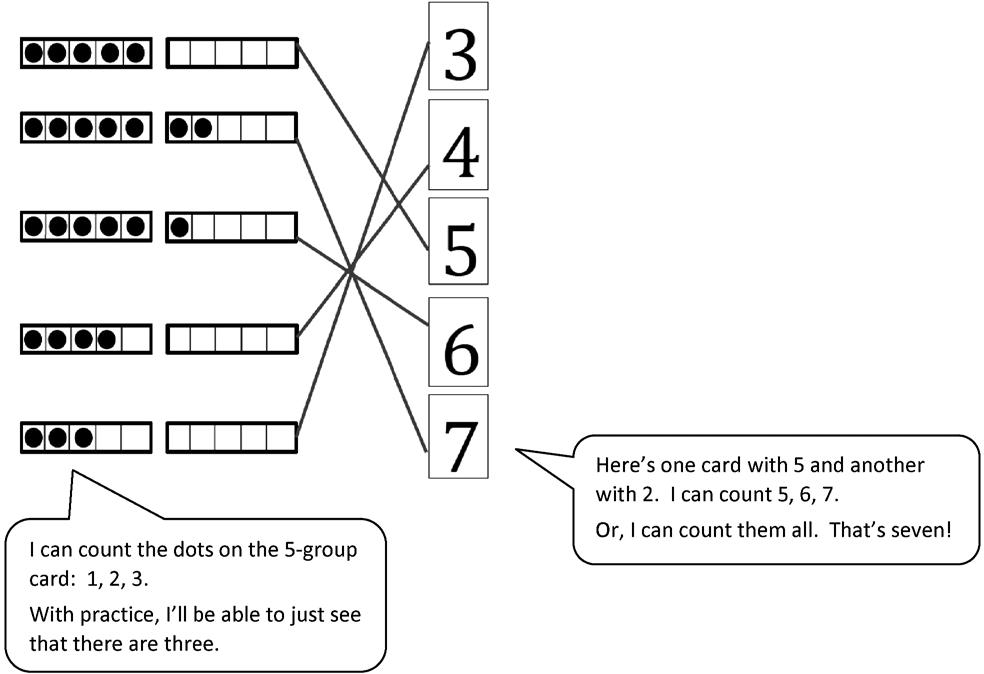
Count 5–7 linking cubes in linear configurations. Match with numeral 7. Count on fingers from 1 to 7, and connect to 5-group images.
Lesson 19:
Lesson 19 Homework
Fill in the missing numbers.

Count 5–7 linking cubes in linear configurations. Match with numeral 7. Count on fingers from 1 to 7, and connect to 5-group images.
Name Date
Draw a line from the 5-groups to the matching numbers. Count 5–7 linking cubes in linear configurations. Match with numeral 7. Count on fingers from 1 to 7, and connect to 5-group images.

How many? Write the number in the box.
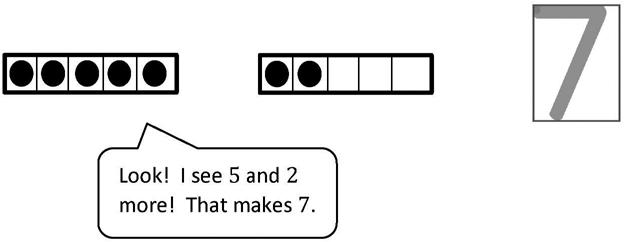
Count how many. Write the number in the box.
Draw a line to show how you counted the triangles.

Reason about sets of 7 varied objects in circular and scattered configurations. Find a path through the scattered configuration. Write numeral 7. Ask, “How is your seven different from mine?”
Lesson 20:
Name Date
How many? Write the number in the box.

Reason about sets of 7 varied objects in circular and scattered configurations. Find a path through the scattered configuration. Write numeral 7. Ask, “How is your seven different from mine?”
Count how many. Write the number in the box. Draw a line to show how you counted the suns.

Count how many. Write the number in the box. Draw a line to show how you counted the circles.

Reason about sets of 7 varied objects in circular and scattered configurations. Find a path through the scattered configuration. Write numeral 7. Ask, “How is your seven different from mine?”
Lesson
Color 4 ladybugs red. Color 4 ladybugs yellow.
Count and circle how many.

Color 4 ladybugs blue. Color 4 ladybugs orange.
Count and circle how many.

Compare counts of 8 in linear and array configurations. Match with numeral 8.
Lesson 21:
Lesson 21 Homework
Count how many. Write the number in the box.

Compare counts of 8 in linear and array configurations. Match with numeral 8.
Name Date
Color 4 squares blue. Color 4 squares yellow.
Count and circle how many.

Color 4 squares green. Color 4 squares brown.
Count and circle how many.

Compare counts of 8 in linear and array configurations. Match with numeral 8.
Lesson 21:
Count how many. Write the number in the box.

Compare counts of 8 in linear and array configurations. Match with numeral 8.
Lesson 22 Homework Helper
Draw 8 beads around the circle.

Color 8. Draw a line to show your counting path.

Arrange and strategize to count 8 beans in circular (around a cup) and scattered configurations. Write numeral 8. Find a path through the scattered set, and compare paths with a partner.
Lesson 22:
Lesson 22 Homework
Count how many. Write the number in the box.

Arrange and strategize to count 8 beans in circular (around a cup) and scattered configurations. Write numeral 8. Find a path through the scattered set, and compare paths with a partner.
Name Date
Draw 8 beads around the circle.

Color 8. Draw a line to show your counting path.
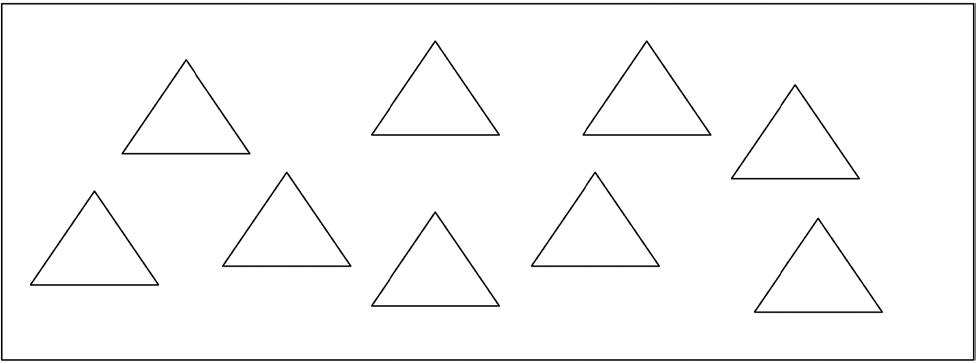
Arrange and strategize to count 8 beans in circular (around a cup) and scattered configurations. Write numeral 8. Find a path through the scattered set, and compare paths with a partner.
Count how many. Write the number in the writing rectangle.

Arrange and strategize to count 8 beans in circular (around a cup) and scattered configurations. Write numeral 8. Find a path through the scattered set, and compare paths with a partner.
Color 9 circles.

Draw 9 shapes.

Organize and count 9 varied geometric objects in linear and array (3 threes) configurations. Place objects on 5-group mat. Match with numeral 9
Lesson 23:
Name Date Color 9 shapes. Color 9 shapes.


Draw 9 circles.

Draw 9 shapes.

Organize and count 9 varied geometric objects in linear and array (3 threes) configurations. Place objects on 5-group mat. Match with numeral 9.
Color 9 circles.

Count. Write the number in the box.
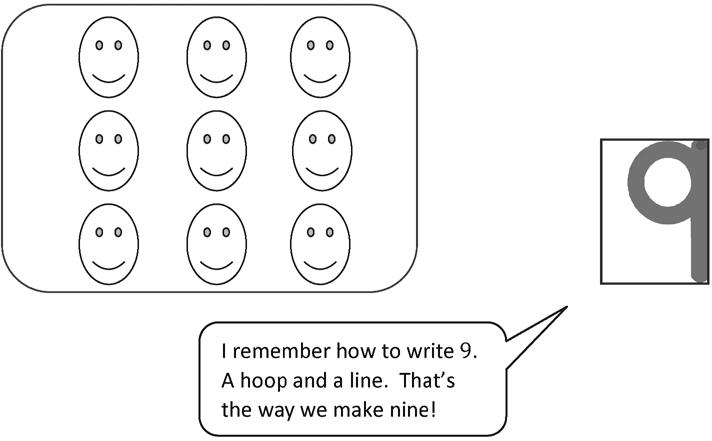
Strategize to count 9 objects in circular (around a paper plate) and scattered configurations printed on paper. Write numeral 9. Represent a path through the scatter count with a pencil. Number each object.
Lesson 24:
Name Date Color 9 circles. Color 9 circles.


Draw 9 beads on the bracelet. Count. Write the number in the box.


Strategize to count 9 objects in circular (around a paper plate) and scattered configurations printed on paper. Write numeral 9. Represent a path through the scatter count with a pencil. Number each object.
Lesson 24:
Color 5 suns. Color 5 more suns a different color.
Color 9 stars. Color 1 more star a different color.

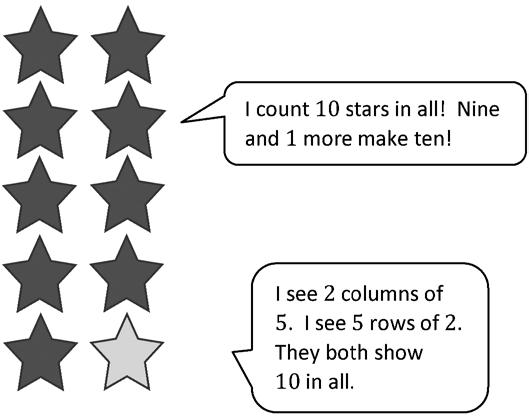
Draw 5 circles under the row of circles. Color 5 circles yellow. Color 5 circles green.

Count 10 objects in linear and array configurations (2 fives). Match with numeral 10. Place on the 5-group mat. Dialogue about 9 and 10. Write numeral 10.
Lesson 25:
Name Date
Color 9 squares. Color 1 more square a different color.

Draw 10 circles in a line. Color 5 circles red. Color 5 circles blue.
Draw 5 circles under the row of circles. Color 5 circles red. Color 5 circles blue.

Count 10 objects in linear and array configurations (2 fives). Match with numeral 10. Place on the 5-group mat. Dialogue about 9 and 10. Write numeral 10.
Draw 5 circles in a row. Draw another 5 circles in a row under them. How many circles did you draw?

Write how many in the box.

Count 10 objects in linear and array configurations (2 fives). Match with numeral 10. Place on the 5-group mat. Dialogue about 9 and 10. Write numeral 10.
Lesson 26:
Name Date
Draw 5 triangles in a row. Draw another 5 triangles in a row under them. How many triangles did you draw? Write the number.

Lesson 26:

Draw enough to make 10.


Draw enough to make 10.

Count 10 objects, and move between all configurations.
Lesson 27:
Name Date
Draw more to make 10.



Draw more to make 10.

Count 10 objects, and move between all configurations.
Lesson 27:
Make up a story about 10 things in your house. Draw a picture to go with your story. Be ready to share your story at school tomorrow.

Act out result unknown story problems without equations.
Lesson 28:
Name Date
Make up a story about 10 things in your house. Draw a picture to go with your story. Be ready to share your story at school.
Act out result unknown story problems without equations.
Lesson 28:
Count the dots. Write how many. Draw the same number of dots below but going up and down instead of across.

Make your own 5-group cards! Cut the cards out on the dotted lines. On one side, write the numbers from 1 to 10. On the other side, show the 5-group dot picture that goes with the number. Order and match numeral and dot cards from 1 to 10. State 1 more than a given number.

Name Date
Count the dots. Write how many. Draw the same number of dots below, but going up and down instead of across. The number 6 has been done for you.

Lesson 29:
Make your own 5-group cards! Cut the cards out on the dotted lines. On one side, write the numbers from 1 to 10. On the other side, show the 5-group dot picture that goes with the number.

Draw the missing stairs. Write the numbers below each step.

Draw 1 more cube on each stair so the cubes match the number. Say as you draw, “1. One more is two. 2 One more is three.”

Make math stairs from 1 to 10 in cooperative groups.
Lesson 30:
Name Date
Draw the missing stairs. Write the numbers below each step.

Ask someone to help you write about what you think baby bear will do now that you have helped him to get home.
Draw 1 more cube on each stair so the cubes match the number. Say as you draw, “1. One more is two. 2. One more is three.”

Make math stairs from 1 to 10 in cooperative groups.
Draw one more circle. Color all the circles, and write how many.

Draw one more star. Color all the stars, and write how many.

Arrange, analyze, and draw 1 more up to 10 in configurations other than towers.
Lesson 31:
Name Date
Draw one more square. Color all the squares, and write how many.

Draw one more cloud. Color all the clouds, and write how many.

Arrange, analyze, and draw 1 more up to 10 in configurations other than towers.
Write the missing numbers.

Draw X’s or O’s to show 1 more.

Arrange, analyze, and draw sequences of quantities of 1 more, beginning with numbers other than 1.
Lesson 32:
Name Date
Write the missing numbers.

Draw X’s or O’s to show 1 more.

Tell someone a story about “1 more...and then 1 more.” Draw a picture about your story.
Arrange, analyze, and draw sequences of quantities of 1 more, beginning with numbers other than 1.
Make 5-Group Cards: Cut the cards out on the dotted lines. On one side, write the numbers from 1-10. On the other side, show the 5-group dot picture that goes with the number. Mix up your cards, and practice putting them in order the “1 less way.”

Order quantities from 10 to 1, and match numerals.
Lesson 33:
Make 5-group Cards
Cut the cards out on the dotted lines. On one side, write the numbers from 1-10. On the other side, show the 5-group dot picture that goes with the number. Mix up your cards, and practice putting them in order in the “1 less” way.

Count and color the triangles. Draw a group of triangles that is 1 less. Write how many you drew.

Count down from 10 to 1, and state 1 less than a given number.
Lesson 34:
Name Date
Count and write the number of objects. Draw and write the number of objects that is 1 less.

Count down from 10 to 1, and state 1 less than a given number.
Count all the squares in each tower, and write how many. Share with someone what you notice!

Arrange number towers in order from 10 to 1, and describe the pattern.
Lesson 35:
Name Date
Count all the squares in each tower, and write how many. Share with someone what you notice!

Arrange number towers in order from 10 to 1, and describe the pattern.
Draw bracelets with the number of beads shown. Write the missing number. Hint: The missing number is 1 less!

Arrange, analyze, and draw sequences of quantities that are 1 less in configurations other than towers.
Lesson 36:
Name Date
Draw bracelets with the number of beads shown. Write the missing number. Hint: The missing number is 1 less!

Fill in the missing numbers.

Arrange, analyze, and draw sequences of quantities that are 1 less in configurations other than towers.
Lesson 36:
Note: Be sure to ask your child about his/her mystery number from today’s Number Fair!
Count how many are in each group. Write the number in the box. Circle the smaller group.
Draw some flowers.

How many?
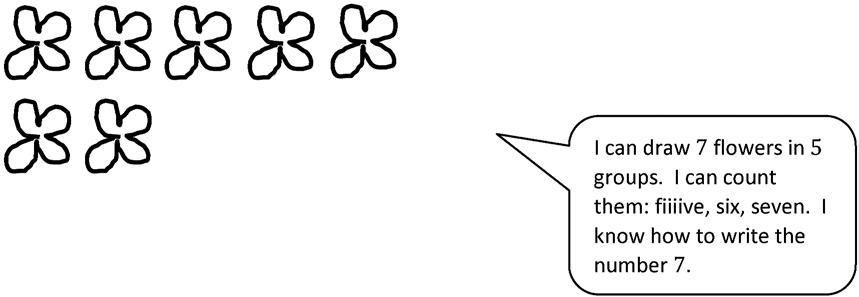

Culminating Task
Lesson 37:
Name Date
Count how many are in each group. Write the number.
CHALLENGE: Circle the smaller group in each row.


Draw some toys you enjoy. Draw some healthy foods.
How many?
Culminating Task
How many?
Grade K Module 2
Draw a line from the shape to its matching object.

Find and describe flat triangles, squares, rectangles, hexagons, and circles using informal language without naming.
Lesson 1:
Name Date
Draw a line from the shape to its matching object.

Find and describe flat triangles, squares, rectangles, hexagons, and circles using informal language without naming.
Lesson 1:
Color the triangles red and the other shapes blue.

Explain decisions about classifications of triangles into categories using variants and non-examples. Identify shapes as triangles.
Lesson 2:
Name Date
Color the triangles red and the other shapes blue.

Draw 2 different triangles of your own.
Explain decisions about classifications of triangles into categories using variants and non-examples. Identify shapes as triangles.
Color all the rectangles red. Color all the triangles green.

In the box, draw 2 rectangles and 2 triangles. How many shapes did you draw? Put your answer in the circle.

Explain decisions about classifications of rectangles into categories using variants and non-examples. Identify shapes as rectangles.
Lesson 3:
Name Date
Color all the rectangles red. Color all the triangles green.

On the back of your paper, draw 2 rectangles and 3 triangles. How many shapes did you draw? Put your answer in the circle.

Explain decisions about classifications of rectangles into categories using variants and non-examples. Identify shapes as rectangles.
Color the triangles blue.
Color the rectangles red.
Color the circles green.
Color the hexagons yellow.

Explain decisions about classifications of hexagons and circles, and identify them by name. Make observations using variants and non-examples.
Lesson 4:
Name
Color the triangles blue.
Color the rectangles red.
Color the circles green.
Color the hexagons yellow.
Date

On the back of your paper, draw 2 triangles and 1 hexagon.
How many shapes did you draw?
Explain decisions about classifications of hexagons and circles, and identify them by name. Make observations using variants and non-examples.
Next to the flower, draw a shape with 4 sides, 2 long and 2 short. Color it green. Below the flower, draw a shape with no corners. Color it red. Above the flower, draw a shape with 3 straight sides. Color it blue.

In the box, draw 3 circles and 2 triangles. How many shapes did you draw? Put your answer in the circle.

Describe and communicate positions of all flat shapes using the words above, below, beside, in front of, next to, and behind.
Lesson 5:
Name Date

Behind the elephant, draw a shape with 4 straight sides that are exactly the same length. Color it blue.
Above the elephant, draw a shape with no corners. Color it yellow.
In front of the elephant, draw a shape with 3 straight sides. Color it green.
Below the elephant, draw a shape with 4 sides, 2 long and 2 short. Color it red.
Below the elephant, draw a shape with 6 corners. Color it orange.
On the back of your paper, draw 1 hexagon and 4 triangles. How many shapes did you draw? Put your answer in the circle.
Describe and communicate positions of all flat shapes using the words above, below, beside, in front of, next to, and behind.
Look around your house. Where can you find a pattern?
Can you find a different pattern in your house?
I know that patterns repeat over and over again. I saw this pattern at my table. The spoon and fork repeated across the table.
Describe and extend repeating patterns.
In class, we used the attributes of shapes with patterns. I can also find patterns in size, shape, or color. This pattern has blue and white stripes that repeat over and over.
Lesson 6:
1. Look at the pattern. Draw what comes next.
2. Draw a pattern you see at home. Describe and extend repeating patterns.
1. Complete the repeating pattern.
A repeating pattern has a part that happens over and over.
Squares and triangles make my pattern. I see 4-sided shapes and 3-sided shapes. A shape is missing!
2. One shape is wrong. Cross it out and fix the pattern.
I can say the pattern out loud to find the part that is missing. I keep saying the pattern to the end to check my work. A 4-sided rectangle goes in the blank.
Describe and extend repeating patterns.
To fix the pattern, first I find the part that repeats by touching each shape as I say the pattern. There are too many small circles in a row. I cross out the small circle that does not belong and draw a large circle above it.
Name Date
1. Draw the missing shapes.
2. Draw the missing shapes.
3. Cross out the shape that does not fit the pattern and draw the correct shape above.
Describe and extend repeating patterns.
Describe and extend repeating patterns.
Lesson 7:
large 5-frame cards
Find objects at your house that can be used to create patterns. Here are some examples of objects you might use: coins, blocks, toys, cereal, snack crackers, candy, pictures, crayons, rocks, leaves, or socks. Use your objects to make 2 different patterns and draw each in a box below. Tell someone about your patterns. I used crayons to make a pattern. A pattern is something that repeats over and over. My pattern is orange, orange, blue crayons.
I made a pattern with coins. The part of the pattern that repeats is penny, nickel. My pattern repeats four times: penny, nickel, penny, nickel, penny, nickel, penny, nickel.
Lesson 8: Create repeating patterns.
Name Date
Find objects at your house that can be used to create patterns. Here are some examples of objects you might use: coins, blocks, toys, cereal, snack crackers, candy, pictures, crayons, rocks, leaves, socks, etc. Use your objects to make 2 different patterns and draw each in a box below. Tell someone about your patterns.
Lesson 8:
Create repeating patterns.
1. Look at this pattern. Color the squares to create the same pattern.
This pattern shows triangle, hexagon over and over. I need to make the same pattern with different-colored squares. When I see a triangle, I can color the square blue. When I see a hexagon, I can color the square red.
2. Create your own pattern. Transfer the pattern using different shapes.
Transfer repeating patterns.
I created a pattern with smiley faces and hearts: smiley face, heart, heart. I will make the same pattern with shapes: square, triangle, triangle.
Lesson 9:
Name Date
1. Make a color pattern in the boxes that is like the shape pattern. Circle the part that repeats in both patterns.
2. Create your own pattern. Make another pattern like it using different shapes. Circle the part that repeats in both of the patterns you made.
Transfer repeating patterns.
Search your house to see what shapes you can find. Draw the shapes that you see. Color your collage.

Culminating task—collaborative groups create displays of different flat shapes with examples, non-examples, and a corresponding solid shape.
Lesson 10:
Name Date
Shape Up Your Kitchen!
Search your kitchen to see what shapes you can find. Make a kitchen-shaped collage by drawing the shapes that you see. Color your collage.
Credits
Great Minds® has made every effort to obtain permission for the reprinting of all copyrighted material. If any owner of copyrighted material is not acknowledged herein, please contact Great Minds for proper acknowledgment in all future editions and reprints of this module.
Modules 1–2: Credits
A Story of Units®
Eureka Math helps students truly understand mathematics and connect it to the real world, preparing them to solve problems they have not encountered. Great Minds teachers and mathematicians believe that it is not enough for students to know the process for solving a problem; they need to understand why that process works.
Eureka Math presents mathematics as a story, one that develops from grades PK through 12. In A Story of Units, our elementary curriculum, this sequencing has been joined with methods of instruction that have been proven to work, in this nation and abroad.
Great Minds is here to make sure you succeed with an ever-growing library of resources, including free tip sheets, resource sheets, and full grade-level modules at eureka-math.org.
Sequence of Grade K Modules
Module 1: Numbers to 10
Module 2: Two-Dimensional and Three-Dimensional Shapes
Module 3: Comparison of Length, Weight, Capacity, and Numbers to 10
Module 4: Number Pairs, Addition and Subtraction to 10
Module 5: Numbers 10–20 and Counting to 100
Module 6: Analyzing, Comparing, and Composing Shapes
On the cover
Vincent van Gogh (1853–1890), The Bedroom at Arles, 1889. Oil on canvas, 57.5 x 74.0 cm. Inv. RF1959-2.
Photo: Hervé Lewandowski
Location: Musée d’Orsay, Paris, France
Photo Credit: © RMN-Grand Palais / Art Resource, NY
What does this painting have to do with math?
In an effort to take advantage of every opportunity to build students’ cultural literacy, Great Minds features an important work of art or architecture on the cover of each book we publish. We select images that we know students and teachers will love to look at again and again. These works also relate, in visual terms, to ideas taken up in the book. In his painting
The Bedroom at Arles, Vincent van Gogh evidenced thoughtful care in his arrangement of objects, not unlike the sort of intentionality we hope A Story of Units will cultivate in students’ manipulation of units.
Published by Great Minds PBC
